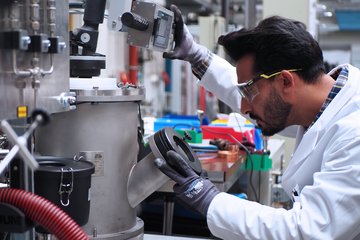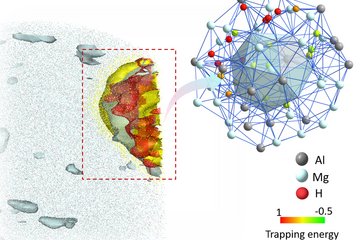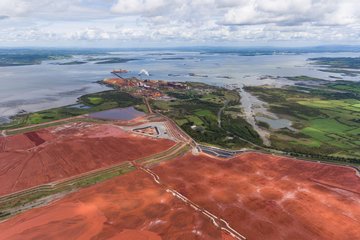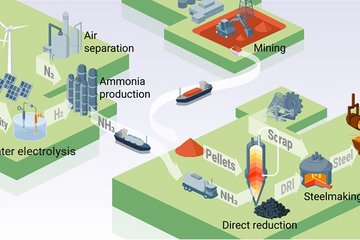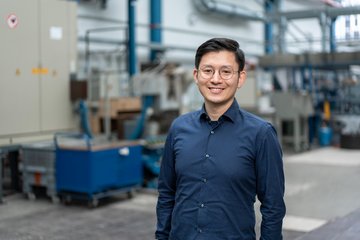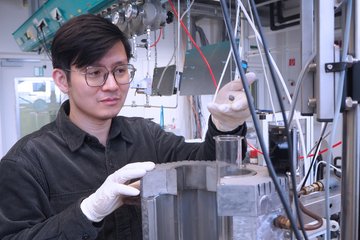Alle Typen
21.
Zeitschriftenartikel
Hot deformation behavior of a Fe3Al-binary alloy in the A2 and B2-order regimes. Intermetallics 13 (12), S. 1304 - 1312 (2005)
22.
Zeitschriftenartikel
Dependence of the brittle-to-ductile transition temperature (BDTT) on the Al content of Fe–Al alloys. Intermetallics 13 (12), S. 1337 - 1342 (2005)
23.
Zeitschriftenartikel
Orientation relationship between a ferritic matrix and k-phase (Fe3AlCx) precipitates formed during metal dusting of Fe–15Al. Intermetallics 13 (12), S. 1332 - 1336 (2005)
24.
Zeitschriftenartikel
Cementite decomposition and coke gasification in He and H2–He gas mixtures. Corrosion Science 46 (3), S. 667 - 679 (2004)
25.
Zeitschriftenartikel
Slip system determination by rolling texture measurements around the strength peak temperature in a Fe3Al-based alloy. Materials Science and Engineering A 387–389, S. 950 - 954 (2004)
26.
Zeitschriftenartikel
APFIM investigations on the intermetallic Ni49.5Al49.5Re1 alloy. Surface and Interface Analysis 36, S. 533 - 539 (2004)
27.
Zeitschriftenartikel
Atom probe field ion microscopy investigations on the intermetallic Ni49.5Al49.5Re1 alloy. Surface and Interface Analysis 36, S. 533 - 539 (2004)
28.
Zeitschriftenartikel
APFIM Investigations on Site Occupancies of the Ternary Alloying Elements Cr, Fe, and Re in NiAl. Ultramicroscopy 101, 2-4, S. 139 - 148 (2004)
29.
Zeitschriftenartikel
Investigation of nucleation mechanisms of recrystallization in warm rolled Fe3Al base alloys. Materials Science Forum 467-470, S. 75 - 80 (2004)
30.
Zeitschriftenartikel
Iron-Aluminium Alloys with Strengthening Carbides and Intermetallic Phases for High-Temperature Applications. Steel Research International 75, 1, S. 55 - 61 (2004)
31.
Zeitschriftenartikel
Metal dusting of ferritic Fe–Al–M–C (M=Ti, V, Nb, Ta) alloys in CO–H2–H2O gas mixtures at 650 °C. Materials and Corrosion 54 (10), S. 778 - 784 (2003)
32.
Zeitschriftenartikel
APFIM investigations on quasi-binary hypoeutectic NiAl–Re alloys. Materials Science and Engineering A: Structural Materials Properties Microstructure and Processing A 353 (1-2), S. 80 - 86 (2003)
33.
Zeitschriftenartikel
Constitution and microstructures of Fe–Al–M–C (M=Ti, V, Nb, Ta) alloys with carbides and Laves phase. Intermetallics 11 (5), S. 443 - 450 (2003)
34.
Zeitschriftenartikel
Effect of Gas Composition on Cementite Decomposition and Coke Formation of Iron. Corrosion Science 45 (2), S. 281 - 299 (2003)
35.
Zeitschriftenartikel
APFIM investigations on site preferences, superdislocations, and antiphase boundaries in NiAl(Cr) with B2 superlattice structure. Materials Science and Engineering A 353, S. 87 - 91 (2003)
36.
Zeitschriftenartikel
Effect of H2S on metal dusting of iron. Materials and Corrosion 54, S. 793 - 798 (2003)
37.
Zeitschriftenartikel
Flow stress anomaly and order-disorder transitions in Fe3Al-based Fe–Al–Ti–X alloys with X=V,Cr,Nb, or Mo. Intermetallics 11 (1), S. 71 - 82 (2003)
38.
Zeitschriftenartikel
Characterisation of the coke formed during metal dusting of iron CO-H2-H2O gas mixtures. Corrosion Science 45, S. 1329 - 1341 (2003)
39.
Zeitschriftenartikel
Coke formation during metal dusting of iron in CO–H2–H2O gas with high CO content. Materials Science and Corrosion 54, S. 770 - 777 (2003)
40.
Zeitschriftenartikel
α-Fe layer formation during metal dusting of iron in CO-H2-H2O gas mixtures. Materials and Corrosion 54, S. 763 - 769 (2003)
